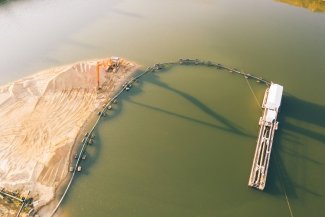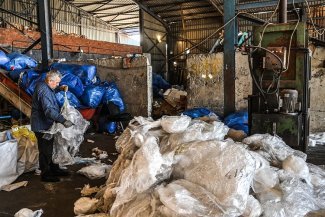Solar panels power water pumps in Kenya’s arid Rift Valley. This technology, supposed to provide an answer to the problem of access to water here, paradoxically involves a system of producing raw materials which affects the world’s water resources.
The issue of the materials used to produce low-carbon technologies (batteries, wind turbines, solar panels, electrified vehicles, etc.) is of fundamental importance and has been the subject of widespread discussion. The water consumption needed for the extraction of minerals and the manufacture of these technologies is also essential, yet far less discussed.
We talk about the pressure on our water supply when it comes to agricultural uses, animal husbandry and more particularly meat production, but we say little about it when it comes to the deployment of low-carbon technologies. In a world increasingly constrained by water resources, this issue will nevertheless become unavoidable, and already is in some regions.
In addition to the known effects of global warming on the water cycle there are the increasing anthropogenic pressures exerted on water resources: between 1900 and 2010, extraction at the global level has multiplied more than seven fold while population size over the same period ‘only’ multiplied by 4.4. Some areas thus find themselves in a state of high water stress, heralding growing conflict over its use between agriculture, industry and the population, and even tensions at the international level.
Energy transition technologies are complex and consume certain materials in large quantities. Lithium, cobalt and even nickel have thus become the star metals in lithium-ion batteries used in electric vehicles. Copper, already omnipresent in our daily lives, could see its demand explode thanks to new forms of mobility, but also to photovoltaic solar energy.
Overall, global energy transition can only be achieved through the intensification of mining throughout the world, leading in turn to an increase in water consumption.
Ever increasing pressure on water resources
At the country level, the mining sector is often far behind agriculture or even other industrial sectors (in Peru, for example, it accounts for about 1 per cent of the country’s water consumption compared to almost 89 per cent for agriculture). It is nonetheless a major consumer, especially during the extraction and processing of minerals and generates many externalities on water (spillage of substances, acid drainage, etc.).
Furthermore, for many of the metals studied, mining and processing are carried out in countries where the pressure on water resources is already strong and for which the water situation is not, in the current state of things, set to improve in the decades to come.
With its high level of water consumption, the rare earths industry is a good illustration of this problem. Research by the public research and training organisation IFP reveals increased pressure on water resources in at least two countries already undergoing episodes of high water stress: China and Australia.
In a constrained climate scenario, the water consumption of the Australian rare earth industry in 2050 would represent more than two-thirds (69.2 per cent) of water abstraction of all industrial sectors in 2015 or 11.2 per cent of total water abstraction in 2015 in the country.
However, rare earth metals are not the only elements concerned by Australia’s proactive mining policy: it is among the top five world producers of lithium, nickel, copper, cobalt and even aluminium. We can only imagine the ‘water footprint’ of the mining sector in a country where episodes of drought are intensifying.
Although less alarming, the situation is similar for China: the largest reserve of rare earths in the world – Bayan Obo in Inner Mongolia – is located in an area where the water stress is described as ‘extremely high’.
In many other mining countries, conflicts over water resources are already a threat.
In Chile, for example, mining activities (copper and lithium) are concentrated in the north of the country, one of the most arid areas in the world. In recent years, there has been a growing mobilisation of Indigenous populations and environmental groups, latterly supported by the Chilean environmental regulator, who decry the depletion of the aquifer located in the Atacama Desert area and the damage caused to ecosystems. Legal battles are multiplying and slowing down mining projects, like that of Rajo Inca, a US$1.2 billion project led by Codelco.
Despite its water resources, Peru suffers chronic water stress due to the unequal distribution, various forms of pollution and the melting of glaciers in the Andean region. Water scarcity and the heavy investment in mining are believed to be the two major triggers of conflict in the region. The mining sector’s environmental footprint thus appears to be ‘the last straw’: the pollution of 16 of the 21 most contaminated rivers is due to existing or past mining or industrial activities according to the National Water Authority (ANA).
The proliferation of conflicts and the scarcity of this resource endanger mining activities and require companies in the sector to anticipate, adapt and innovate.
In response to the water challenge, companies are seeking, in particular, to reduce their consumption by improving the efficiency of their operating and processing activities. The development of an innovative process for direct lithium extraction suitable for the waters of the Argentinean salt flats by IFP Energies Nouvelles and Eramet illustrates, for example, this type of challenge. The Chilean company SQM, which specialises in lithium, wishes, thanks to its innovations, to reduce its water consumption by 30 per cent by 2030. In the copper industry, the improvement of water recycling processes has made it possible to increase the share of recycled water in the sector’s total consumption from 72.7 to 76.4 per cent between 2018 and 2019.
Another option has been very successful in the region in recent years: the use of desalination. Cochilco (the Chilean Copper Commission) estimates that the use of seawater should more than triple by 2029. The viability of such a strategy raises questions, however, as the pumping and treatment of seawater and the transporting of water over thousands of kilometres across the Andes require investment as well as materials and energy. In short, an energy-intensive and material-intensive process.
The exploitation of aquifers by means of drilling is another of the possibilities exploited to cope with the lack of water. In early 2020, at the height of the Australian drought, Glencore opted for this solution to supply water to its CSA copper mine in New South Wales. Here too, the drilling carried out to exploit already threatened groundwater raises questions.
The ‘water footprint’, a poorly understood indicator
In this context, greater awareness among citizens over the issue of water consumption is needed to move towards greater abstemiousness. It is embodied in particular in the notion of our ‘water footprint’, which corresponds to the quantity of water used in a territory for a given population to meet all of its needs. It thus incorporates, in addition to the tap water consumed, the water needed for the production of goods and services produced on national territory but also imported.
The water footprint of the citizens of OECD countries is higher, on average, than that of those in non-OECD countries. That of a French person is, for example, over 200m3/inhabitant/year while the global average is 167m3/inhabitant/year.
Moreover, it turns out that the French water footprint is about three times higher than the volume of water consumed at the domestic level. Similar to carbon footprints, a large portion of a French person’s water consumption comes from the fact that the amount of water used to produce goods and services imported into France is greater than for goods and services exported from France.
This failure to take into account our water footprint accentuates the gap between the user’s perception of their consumption and the reality of the impact of their lifestyle on water resources.
This situation is further aggravated by the strong tolerance of leaks of drinking water from pipes (around 20 per cent of water is lost in this way in France) by citizens and operators, which holds back the later from investing massively in infrastructure maintenance.
As with energy or materials efficiency, a change in purchasing behaviour is necessary and this will require better consumer information with, for example, mandatory labelling of the water content of products.
The environmental water footprint of recycled minerals is much smaller than that of minerals directly extracted from the subsoil. Water consumption can be divided by five in the case of rare earths, by ten in the case of copper or even by 20 in the case of cobalt. When we know that only 42.5 per cent of the total waste from electrical and electronic equipment was recycled within the European Union of 28 in 2019, the promotion of collection and recycling would appear to be an interesting option to pursue.
The implementation by the public authorities of public policies to promote a circular economy could also bring benefits that go beyond reducing the pressure on resources.
According to the French Circular Economy Institute, it would allow the creation or strengthening of job-creating sectors, an argument all the more relevant in the context of the economic crisis created by the Covid-19 pandemic. It would also strengthen the sovereignty of the French state and more broadly of the countries of the European Union in their supply of critical metals.
Finally, supporting research and innovation around cutting-edge industrial processes is also a lever for improving water management in the sector while consolidating the influence of French companies internationally.
Blue gold: a common good or private property?
The mining industry, and our populations, will also have to face increasing uncertainty around the conditions of access to blue gold. Two opposing phenomena are developing.
On the one hand, there is movement towards the commodification of water resources, the latest highly symbolic manifestation of which was the introduction of a water futures contract on the Chicago Mercantile Exchange at the end of 2020.
On the other hand, some populations or communities claim water as a fundamental human right and intend to oppose any attempts by the private sector to monopolise it.
Among the countries mentioned here, Chile is an evocative example. Praised by the Chilean people, the proposed new constitution could return water, privatised since 1981, to the status of a common good, which will create uncertainties for the mining sector.
This movement to reappropriate water as a public good can also be seen in some Western countries. This is what happened in Paris, for example, with the remunicipalisation of the public water service in 2009 and, since 2010, the Eau de Paris authority has been responsible for all distribution.
Although it is a modest user of water compared to the agricultural sector, the mining industry will, like all other sectors, have to contend in a world where the spectre of the water crisis feared by the United Nations is likely to become a reality and where every drop of water consumed will count.














